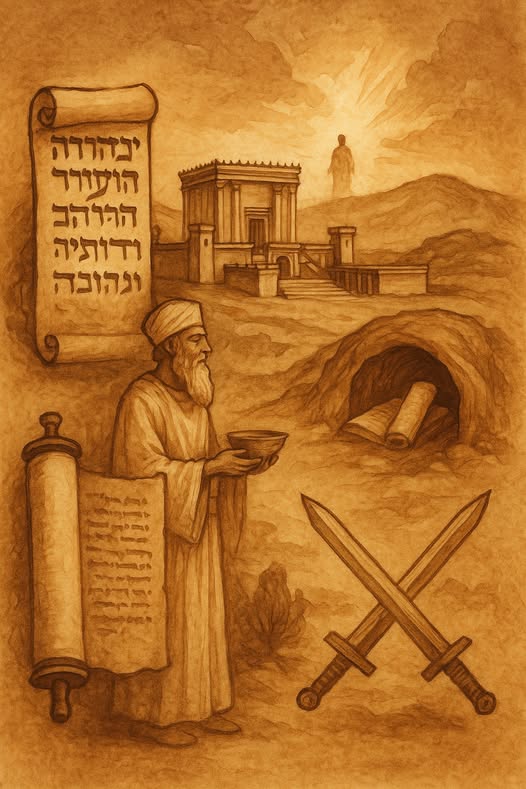
By the time Jesus began His public ministry in the early 1st century AD, the Jewish people were living under Roman occupation, governed politically by Herodians and the prefecture of Pontius Pilate. Spiritually, however, they were under the heavy influence of a complex, fragmented religious landscape. This world was shaped not only by the Torah and the Temple, but also by oral traditions, sectarian movements, and apocalyptic hopes born out of centuries of oppression.
Roots in the Return from Exile
The religious foundation of Second Temple Judaism was laid during and after the return from Babylonian exile (late 6th century BC). The destruction of Solomon’s Temple in 586 BC and the subsequent captivity led to the rise of new religious emphases. With no access to a physical temple during exile, the Jews began placing greater emphasis on Torah study, prayer, and communal identity. When the Second Temple was completed in 516 BC, it never regained the glory of Solomon’s version, and a deep longing for restoration remained.
During this period, figures like Ezra and Nehemiah re-established the Torah as central to Jewish life, leading to the eventual rise of a scribal class that would later influence the Pharisees. Meanwhile, lingering prophecies about the coming of the Messiah and the Day of the Lord took on heightened significance.
The Rise of Jewish Sects
By the time of Jesus, Second Temple Judaism was no longer a unified religious system, but a diverse and often divided environment made up of several sects and movements. Each group claimed to uphold Israel’s true identity and faithfulness to God, yet they differed sharply in how they interpreted Scripture, how they viewed the Temple, and how they responded to Roman rule. Some sought purity through withdrawal, others through precision in law-keeping, while still others pursued political resistance or religious control. Understanding these groups and their core beliefs helps us better grasp the tensions Jesus encountered—and the ways in which His message stood apart from all of them.
Pharisees: Tradition, Resurrection, and Popular Influence
The Pharisees were a respected and influential sect who emphasized both the written Torah and a detailed oral tradition that sought to apply God’s law to every aspect of daily life. They believed strongly in the resurrection of the dead, the existence of angels and demons, final judgment, and the sovereignty of God—doctrines that closely paralleled the teachings of Jesus. Their network of synagogues and their concern for purity gave them a grassroots presence that made them popular among the common people.
Although they are frequently portrayed in the Gospels as opponents of Jesus, the conflict was not rooted in core theology but in their interpretation and practice. Jesus confronted their legalism and their tendency to place tradition above compassion, but He also acknowledged their authority and devotion to the law (Matthew 23:2–3). Not all Pharisees were hostile. Some, like Nicodemus and Paul, were deeply impacted by Jesus’ message and played important roles in the story of the early church.
While Jesus challenged their behavior and inconsistencies, the Pharisees were far more theologically aligned with Him than the Sadducees or Zealots. Their emphasis on personal holiness, Scripture, and resurrection ensured that much of their influence would continue into later rabbinic Judaism after the destruction of the Temple.
Sadducees: Temple Control and Scriptural Minimalism
The Sadducees, often drawn from priestly and aristocratic families, controlled the Temple in Jerusalem and were responsible for the sacrificial system. Theologically, they rejected the oral traditions of the Pharisees and held only to the written Torah. As a result, they denied doctrines not explicitly found in the first five books of Moses—such as the resurrection of the dead, the afterlife, and the existence of angels or spirits.
This made them theological minimalists and political pragmatists, favoring cooperation with Rome to preserve their power. Their relationship with the Pharisees was deeply antagonistic, especially over resurrection and ritual interpretation. Jesus directly confronted them in debates about resurrection (e.g., Matthew 22:23–33), exposing their limited framework.
Essenes: Purity, Dual Messiahs, and Separation
The Essenes were separatists who believed the Temple priesthood had been corrupted. They withdrew into wilderness communities, most famously at Qumran, and lived according to strict purity laws and communal discipline. Their theology emphasized dual Messianism: one priestly and one kingly figure. They anticipated a final battle between the Sons of Light and the Sons of Darkness, revealing a cosmic dualism reminiscent of Zoroastrian influence but grounded in Jewish apocalyptic tradition.
They produced vast libraries, including the Dead Sea Scrolls, which reveal their obsession with calendar reform, purity laws, and covenant faithfulness. Though Jesus is never shown interacting with the Essenes, their eschatological fervor mirrors aspects of His ministry. They had little interaction with the Pharisees or Sadducees, viewing both as corrupt.
Zealots: Nationalism and Divine Violence
The Zealots believed that God alone should rule Israel and that violent rebellion against Rome was both justified and necessary. Drawing on the legacy of the Maccabees, they awaited a messianic deliverer who would restore the kingdom of David by force. Some scholars view them as more of a movement than a structured sect, but their theological conviction that God would bless their uprising set them apart.
They rejected cooperation with the Sadducees and saw the Pharisees as too passive. While Jesus included a Zealot (Simon) among His disciples, He rejected the path of violence. His entry into Jerusalem on a donkey stood in stark contrast to the militaristic expectations of a conquering king.
Interactions and Power Struggles
The various sects clashed both theologically and politically. The Sadducees despised the Pharisees’ oral law, while the Pharisees viewed the Sadducees as worldly compromisers. The Essenes considered both groups illegitimate. The Zealots threatened the stability that both Sadducees and Pharisees tried to maintain. These divisions created an atmosphere of suspicion, rivalry, and debate.
Conclusion
The religious world Jesus entered was anything but uniform. Competing interpretations of Scripture, fractured leadership, and rising apocalyptic expectations created a volatile environment. Each group—the Pharisees, Sadducees, Essenes, and Zealots—believed they were upholding the true path of faithfulness to God. Into this charged landscape came a rabbi from Nazareth who both fulfilled and upended expectations.
Jesus did not align Himself with any one faction. Instead, He exposed the flaws within each, while affirming the truths they grasped in part. He taught with authority, called people to repentance, and proclaimed a Kingdom that was not of this world. The complexity of Second Temple Judaism helps us understand not only the world He challenged, but also the depths of the message He brought.
Discussion Questions
- How did the exile shape the religious identity of Second Temple Jews?
- What were the primary theological differences between the Pharisees and the Sadducees?
- Why did Jesus often clash with the Pharisees, even though they shared many core beliefs?
- How can we better understand the Pharisees as a complex and sincere religious movement rather than simply as opponents of Jesus?
- In what ways did apocalyptic literature influence the Jewish expectation of the Messiah?
Want to Know More?
- “The New Testament in Its World” by N.T. Wright and Michael F. Bird
A comprehensive guide to the historical and theological background of the New Testament, including the world of the Pharisees and other sects. - “The Complete Dead Sea Scrolls in English” translated by Geza Vermes
Insight into the Essenes and their apocalyptic worldview, preserved in the scrolls found at Qumran. - “Second Temple Judaism: The History and Literature of Judaism between the Exile and the Mishnah” by Lester L. Grabbe
An in-depth survey of the diverse beliefs and practices in Jewish life during the Second Temple period. - “Jesus and Judaism” by E.P. Sanders
A foundational work that re-evaluates Jesus in light of contemporary Jewish beliefs, especially those of the Pharisees, challenging long-held misconceptions. - “The Misunderstood Jew: The Church and the Scandal of the Jewish Jesus” by Amy-Jill Levine
Written by a Jewish New Testament scholar, this book explores how Christian teaching has often misrepresented Judaism and offers a more accurate understanding of the Pharisees. - “The Jewish War” by Josephus (translated by G.A. Williamson)
A firsthand account of Jewish sects, messianic hopes, and the eventual destruction of the Temple by someone who lived through the era.




